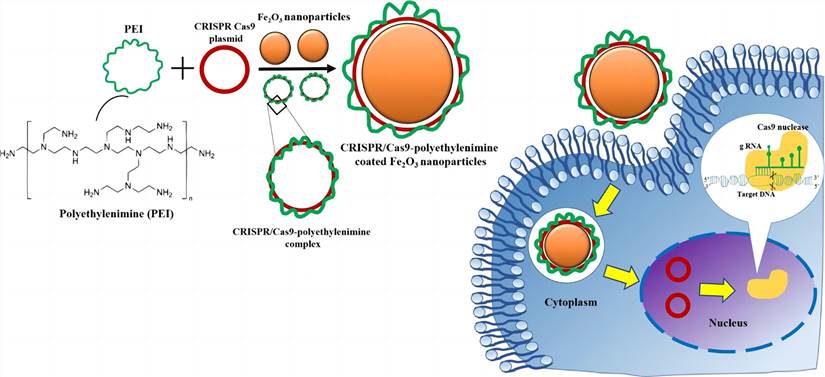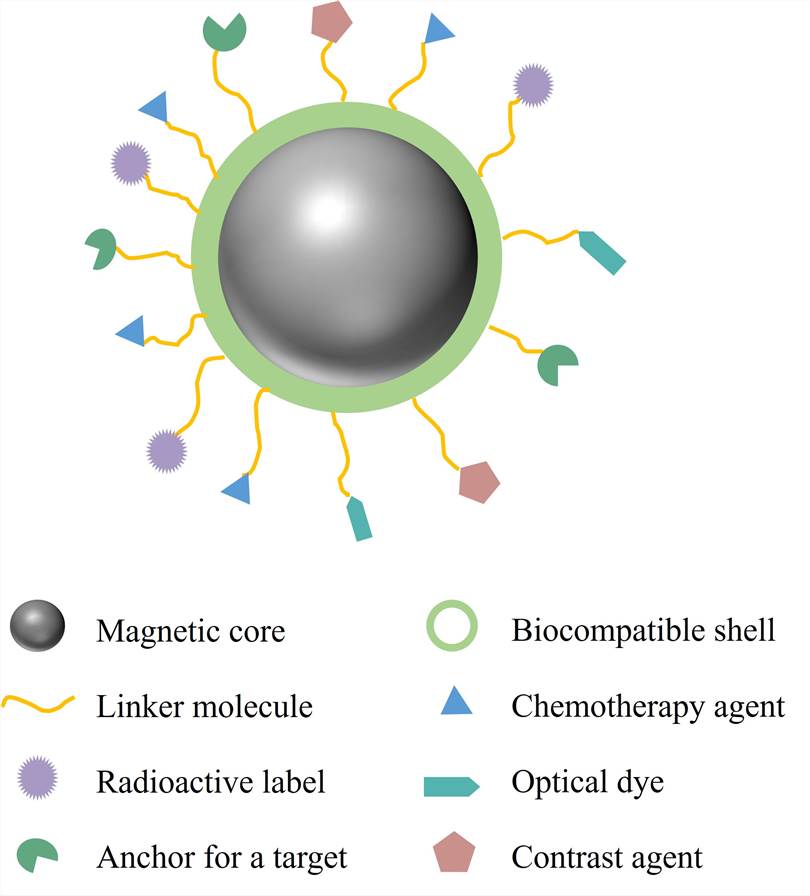Magnetic Nanoparticle Development
InquiryCD Formulation is a pioneering company specializing in the design and engineering of magnetic nanoparticles (MNPs) for gene and cell therapies. Our development services are dedicated to driving progress in nucleic acid medicines and unlocking new treatment possibilities for challenging conditions.
What are MNPs?
MNPs refer to small particulate structures between 1-100 nm in size that exhibit strong magnetic properties. They are typically composed of magnetic metals or metal oxides. At the nanoscale, materials can display unique magnetic behaviors, such as superparamagnetism where particles act like little magnets when exposed to an external magnetic field but do not retain residual magnetism after removal of the field. This makes MNPs attractive for applications in areas like the biomedical sciences.
 Schematic diagram of MNP synthesis and transfection for CRISPR/Cas9 plasmid delivery (Dowaidar M.; et al. 2017)
Schematic diagram of MNP synthesis and transfection for CRISPR/Cas9 plasmid delivery (Dowaidar M.; et al. 2017)
Our Materials for MNPs Development
|
Iron Oxide |
Magnetic iron oxide nanoparticles, such as magnetite (Fe3O4) and maghemite (γ-Fe2O3), are widely studied due to their biocompatibility and strong magnetic properties. |
| Cobalt Ferrite |
Cobalt ferrite (CoFe2O4) has high magnetic saturation and is commonly explored for hyperthermia applications. |
| Nickel Ferrite |
Nickel ferrite (NiFe2O4) has magnetic functionality and is less toxic than other ferrites. |
| Manganese Ferrite |
Manganese ferrite (MnFe2O4) has strong magnetocrystalline anisotropy for effective magnetic control/targeting. |
| Alloys |
Alloys of iron and platinum or iron and gold can enhance biocompatibility versus metal oxide cores. |
| Complex Oxides |
Complex oxide nanoparticles containing combinations of iron, cobalt, and manganese offer tunable magnetic and electric properties. |
What Functional Modifications Can We Make to MNPs?
We can develop MNPs with shells, for example using polymers, silica or lipid bilayers, to improve stability and biocompatibility.
Functional groups or ligands can be attached to the surface of MNPs to achieve specific targeting of cells or tissues, improve delivery efficiency, and reduce off-target effects.
We can combine MNPs with imaging agents, such as fluorescent dyes or contrast agents, to enable real-time monitoring, imaging, and tracking of nanoparticles in biological systems.
MNPs can be designed to respond to external stimuli such as magnetic fields, temperature or pH, allowing triggered release of encapsulated drugs or controlled drug release under specific conditions.
Applications of Our MNPs Development Services
We can use MNPs to encapsulate therapeutic agents such as drugs, proteins, and nucleic acids and deliver them to target sites through external magnetic fields, improving treatment effectiveness.
Our magnetically guided cell-loaded nanoparticles enable targeted transplantation of stem cells and immune cells, advancing regenerative medicine and cancer immunotherapy.
Our magnetic hyperthermia technology uses AC magnetic fields to generate heat from MNPs in tumors, thermally ablating cancer cells for minimally invasive tumor ablation.
We develop magnetic scaffolds containing nanoparticles that enable directional cell alignment and growth to repair tissues like bone and cartilage for regenerative therapies.
Our technology platform enables customers to engineer MNPs as advanced diagnostic tools for technologies such as MR imaging and magnetic particle imaging or functionalize them to detect biomarkers for proteins and antibodies.
Advantages of Our MNPs Development Services
- Improve nucleic acid delivery efficiency and/or reduce toxicity.
- Targeted drug delivery to various tissue types, even at the cellular or subcellular level.
- Improve the pharmaceutical properties of therapeutic molecules, such as stability, solubility and in vivo circulation time.
- Increased drug concentrations in diseased organs.
- Overcome biological barriers (such as the BBB).
- Possibility of simultaneous diagnosis and treatment.
At CD Formulation, we utilize a multidisciplinary approach to designing and customizing MNPs. For inquiries and to explore how our MNP development services can revolutionize your drug delivery strategies, please contact us!
References
- Rohiwal S.S.; et al. Polyethylenimine based magnetic nanoparticles mediated non-viral CRISPR/Cas9 system for genome editing. Sci Rep. 2020, 10(1):4619.
- Panday R.; et al. Advances in magnetic nanoparticle-driven delivery of gene therapies towards prostate cancer. J Nanomater. 2021, 2021: 1-10.
- Tang C.; et al. Application of magnetic nanoparticles in nucleic acid detection. J Nanobiotechnology. 2020, 18(1):62.
Related Services



 Schematic diagram of MNP synthesis and transfection for CRISPR/Cas9 plasmid delivery (Dowaidar M.; et al. 2017)
Schematic diagram of MNP synthesis and transfection for CRISPR/Cas9 plasmid delivery (Dowaidar M.; et al. 2017)